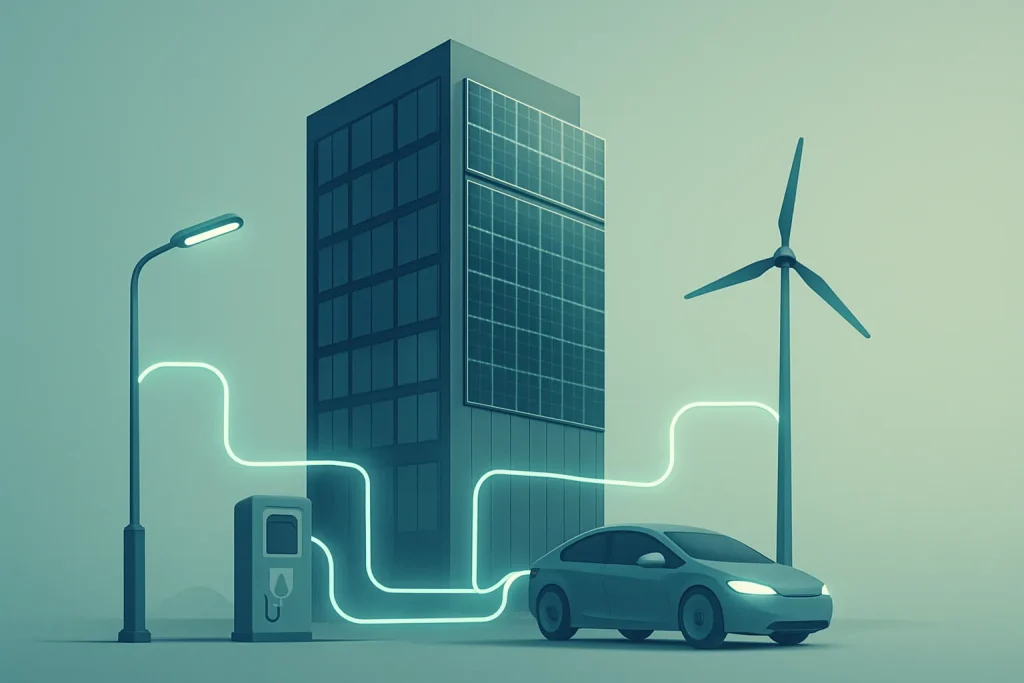Discover how cities and buildings are revolutionizing energy efficiency through smart infrastructure. This article presents real-world success stories from Toronto to Singapore, showcasing innovative solutions in action. Drawing on insights from industry experts, we explore how cutting-edge technology is transforming urban environments and delivering substantial energy savings.
- Smart Retrofit Slashes Energy Use in Toronto
- Sensors Boost Efficiency in Commercial Building
- Tacoma’s IoT Upgrade Yields Substantial Savings
- Masdar City Showcases AI-Powered Energy Management
- Singapore’s Smart Grid Optimizes District Energy
- Amsterdam’s Edge Building Automates for Efficiency
Smart Retrofit Slashes Energy Use in Toronto
One successful example we’ve implemented involved integrating smart infrastructure into a mid-sized commercial building retrofit in Toronto. The client wanted to reduce operational costs while meeting new sustainability benchmarks, so we designed a system that combined solar PV generation, smart building automation, and advanced energy monitoring.
Here’s how it worked:
- Smart building automation controlled HVAC, lighting, and equipment schedules based on real-time occupancy data, weather forecasts, and peak demand alerts.
- IoT-enabled sensors tracked temperature, air quality, and power consumption in every zone, feeding data into a central platform.
- Solar + storage integration ensured the building could offset peak grid usage and store excess energy for later use, reducing strain during high-demand periods.
- AI-driven analytics identified inefficient patterns—such as simultaneous heating and cooling in different areas—and automatically adjusted system operations to correct them.
Outcomes:
- Reduced the building’s annual energy consumption by 28% within the first year.
- Achieved a 32% drop in peak demand charges by intelligently shifting high-load operations.
- Improved occupant comfort through precise environmental controls, resulting in higher tenant satisfaction scores.
- Secured a faster ROI on the solar installation by pairing production data with demand-side savings.
The success of this project reinforced the value of linking renewable generation with intelligent control systems. It’s not just about producing clean energy—it’s about ensuring every kilowatt is used as efficiently as possible.
 Matthew Jaglowitz
Matthew Jaglowitz
CEO, Exactus Energy Inc.
Sensors Boost Efficiency in Commercial Building
I recently worked on a project where we implemented smart lighting and HVAC systems in a commercial building. By installing sensors that adjusted the lighting and temperature based on occupancy and time of day, we reduced unnecessary energy use. The HVAC system, for example, would only run at full capacity when it detected active zones in the building, cutting energy waste in unoccupied areas. After just six months, energy consumption dropped by 20%, and the building’s utility costs were significantly lower. This shift not only improved energy efficiency but also enhanced the overall comfort for occupants, as the environment adapted more dynamically to their needs. The success of this project has made me a firm believer in the power of smart infrastructure to create sustainable, cost-effective solutions in energy management.
 Nikita Sherbina
Nikita Sherbina
Co-Founder & CEO, AIScreen
Tacoma’s IoT Upgrade Yields Substantial Savings
In the Hilltop neighborhood of Tacoma, Washington, a transformation took place when Tacoma Power and the city collaborated to retrofit multi-purpose buildings with smart infrastructure. There were no huge skyscrapers or brand-new developments, just older buildings that were in need of an energy-efficient facelift. It cut energy waste by connecting IoT-based HVAC controls, occupancy sensors, and advanced submetering systems that sense occupant patterns in real-time to automatically adjust heating, cooling, and lighting.
In less than 18 months, the pilot buildings saw their energy usage fall by a massive 27%, equating to more than $110,000 worth of savings per year! Going a bit deeper than the numbers, what impressed me was how scalable the strategy was; that is, small-to-mid-sized districts can implement comparable low-disruption solutions without large-scale overhauls. If you are doing a revitalization project on an older district, start with energy mapping and behavior-based automation. When small changes are combined with data to carry them out, they can have absolutely significant impacts.
 Jonathan Garini
Jonathan Garini
Founder & CEO | Enterprise AI Strategist, fifthelement
Masdar City Showcases AI-Powered Energy Management
When I was in Abu Dhabi, I went to visit “Masdar City,” which is a futuristic urban development where sustainability comes first. This was not just a stunning architectural design or futuristic transit that intrigued any onlooker – it was the smart infrastructure behind the scenes. In another building, I walked through the first floor, which had AI-powered energy management systems that could turn lighting and HVAC on or off based on real-time occupancy and even change according to weather patterns. These sensors were doing more than just reacting; they were learning how to predict. That building alone reduced its electricity usage by almost 40% of its whole facility simply by minimizing waste and increasing efficiency.
My takeaway from this is that retrofitting is not necessarily about just ripping everything out. Smart controls for lights, integrated meters, and adaptive systems that “learn” about how the building is used can be retrofitted even into older structures. I found it very useful since it allowed me to turn something that is usually abstract into something actionable. The technology is there; it just has to be adopted in a complementary approach to how people actually utilize space. Do not underestimate the power of small, smart changes in the energy market.
 Nikolay Petrov
Nikolay Petrov
Chief Technology Officer | Founder, ZontSound
Singapore’s Smart Grid Optimizes District Energy
One standout example I’ve observed is Singapore’s Punggol Digital District, which integrates a centralized smart energy system across commercial and educational buildings. Instead of each building operating independently, the district shares cooling and power resources using a smart grid that dynamically adjusts based on real-time demand.
What makes this model effective is the use of district-wide sensors and predictive algorithms to manage energy loads. When occupancy drops in one building, energy is redirected to areas of higher use without waste. This has led to energy savings of up to 30 percent compared to traditional setups, while also reducing operational costs and carbon footprint.
It’s a compelling case of how urban planning and technology can work together to make infrastructure more intelligent and efficient. As marketing professionals, we draw inspiration from this kind of innovation, especially when designing campaigns around sustainability and smart tech for clients in real estate or construction.
 Eugene Leow Zhao Wei
Eugene Leow Zhao Wei
Director, Marketing Agency Singapore
Amsterdam’s Edge Building Automates for Efficiency
Take the Edge building in Amsterdam—it’s basically the poster child for smart infrastructure. The building has been equipped with thousands of sensors to track light, temperature, and occupancy, and the system adjusts everything automatically to save energy. Even the cleaning crew uses data to determine which desks were actually used that day. It’s not just eco-friendly; it’s insanely efficient. The building essentially runs itself while keeping people comfortable and significantly reducing waste. This is the future, and it’s already here.
 Justin Belmont
Justin Belmont
Founder & CEO, Prose







